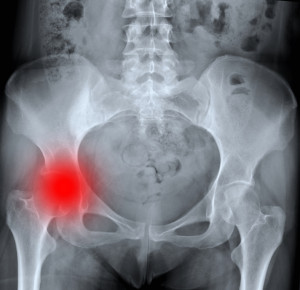
What is Avascular Necrosis?
Avascular Necrosis (AVN) is a disabling and painful condition that can affect many bones in your body, most commonly in the hip and knee joints. Also known as osteonecrosis or “bone rot”, it is caused by a loss of blood supply and subsequent injury to the bone. Certain anatomical areas are more susceptible to this process due to their already tenuous blood supply. For example, the reason that AVN is so common in the hip is that the head of the femur gets its blood supply in a retrograde fashion; that is, the blood flow has to make a u-turn from its path down the leg and travel upwards to reach its destination.
Once the blood flow is compromised, bone cells begin to die and start to lose structural integrity. This process is very painful and often makes walking difficult. As the disease progresses, the round, smooth joint surface begins to collapse and lose its smooth contour. The affected joint then becomes stiff and the cartilage begins to wear away causing arthritis.
What are the Causes of AVN?
Avascular necrosis can be caused by conditions that cause your blood to become thick and sticky or conditions that damage your arteries. When this happens your blood has more difficulty traveling through small arteries. Diseases that increase the risk of AVN include sickle cell disease, rheumatoid arthritis, and other autoimmune diseases. Steroid use and alcohol intake are also associated with avascular necrosis, especially large quantities over a long time period. Scuba divers can also get AVN when they surface too quickly and small nitrogen bubbles obstruct blood flow.
Treatments for AVN by our NJ Orthopedic Surgeons
Avascular necrosis can be treated successfully in many cases if it is diagnosed early. The goals of treatment are to allow healing of the damaged (necrotic) bone and prevent collapse of the joint surface. Certain medications have been shown to strengthen and stabilize the bone, which can reduce pain and slow down the process of AVN. Surgical treatments can improve blood supply to the necrotic area and provide structural support while allowing the bone to heal. Core decompression is a surgical procedure that involves drilling the necrotic bone.
A new procedure using the Zimmer Osteonecrosis Intervention Implant has shown improved success. This technique uses trabecular metal, which is inserted into the necrotic area. The trabecular metal implant provides structural support, preventing collapse, and its unique micro-architecture allows bone tissue to grow into the metal forming an extremely strong bond.
One of our NJ orthopedic surgeons, Dr. Nasar, is one of a small group of surgeons who has performed the Zimmer Osteonecrosis Intervention Implant procedure.







